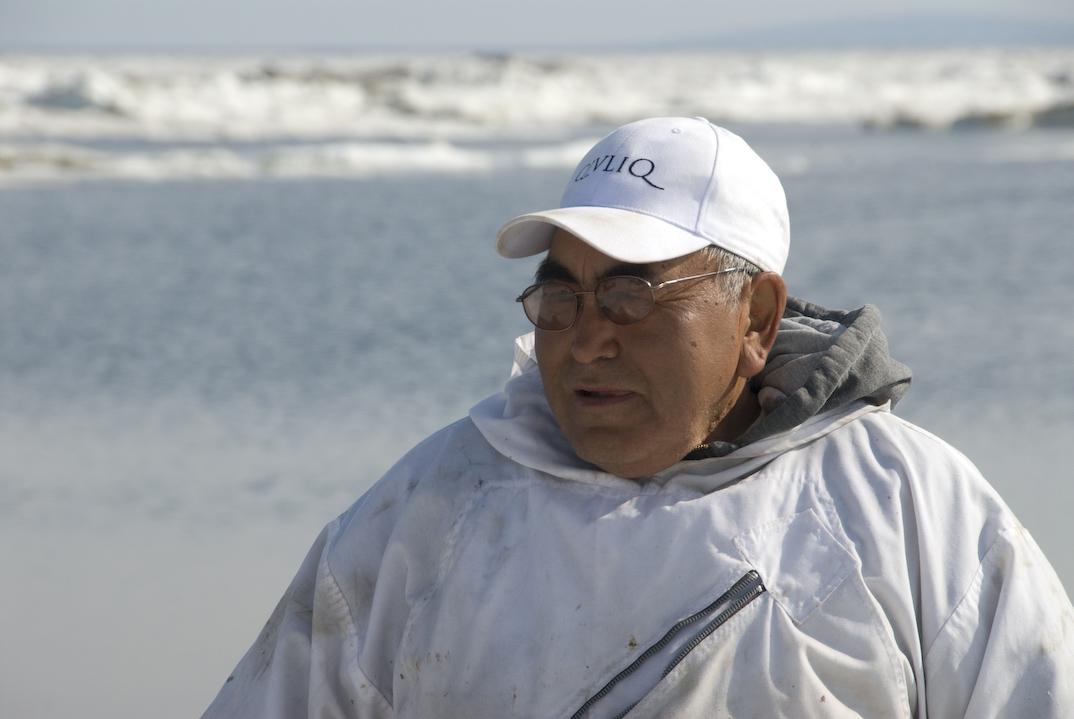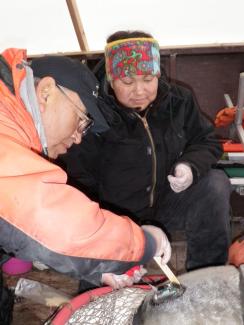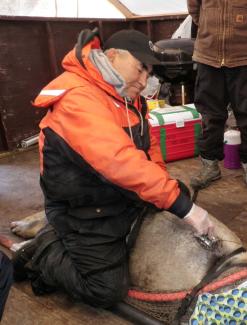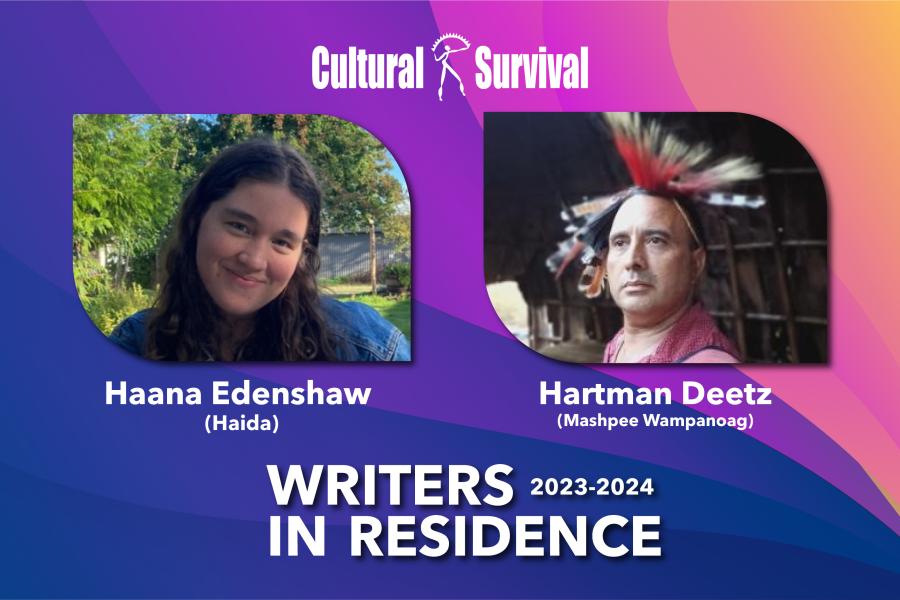
By Brandon M. Chapman, Ph.D. and John Goodwin
Throughout the history of the Iñupiaq as a people, as with many Indigenous groups, subsistence has been a crucial cultural avenue for passing on knowledge, sustaining an economic livelihood and cultural lifestyle, feeding the population, and constituting the local diet. Among the Iñupiaq, subsistence techniques and livelihoods are not just “traditional relics” relegated to only a few members of the older generations and a dwindling practice. This continued practice of subsistence is especially vivid among the Iñupiaq residents of the Northwest Arctic Borough, one of two tribal administrative regions in Alaska above the Arctic Circle. The Alaska Natives Commission reported an estimate of over 1,000 pounds per person of subsistence harvest for the Northwest Arctic Borough, more than double that of per capita subsistence harvest for its arctic neighbors in the North Slope Borough and over 200 pounds more than the second highest per person harvest in the state. This is more than four times what the average American uses annually in meat, about 222 pounds (about 100 kilos) of store-bought meat, fish, and poultry annually and nearly reaches the total amount of annual food an average American uses at about 1,370 pounds. Also unique to the Northwest Arctic is the emphasis on marine mammal and caribou hunting as the arctic region of Alaska is the only in the state where fishing does not constitute a majority of subsistence resources harvested.
While subsistence remains prominent among the Iñupiaq of the Northwest Arctic and notes continuity of portions of the culture and availability of subsistence resources over time (such as the behavior of animals and procurement techniques used by Iñupiaq), there have also been changes shaping these practices including technology (especially the transition nearly two generations ago from dog team to snow-machine transportation when the region is iced-over) and climate change. Despite these major changes, residents of the Northwest Arctic are adapting.
There are few Iñupiaq left who have seen and lived through these events over the past half century to century. Iñupiaq Elder, marine mammal hunter, and Chairman of the Federal Ice Seal Committee, John Goodwin, is one of them. As part of an oral life history, John related his more than fifty years experience as a subsistence harvester and observer across the Northwest Arctic. He explained these events and his experiences with these changes as an Iñupiaq hunter. The following is a summary of some of the main themes from his history regarding the cultural ways and conditions of subsistence in the region.
John was born at a winter seasonal camp between the Northwest Arctic communities of Kotzebue and Noatak in December 1942 and spent most of his childhood in Kotzebue. He has a lifetime of experience with hunting and fishing having started getting food as an adolescent. “I started with grandpa at age nine, hunting bearded seals in spring time, my main chore was to bail the boat, and I was learning hunting from grandpa.” As many Iñupiaq youth do who are taught how to get food, John learned primarily from his grandfather and joined him on hunting and fishing expeditions as a child. “Our culture, normally, we as men, we as boys, were taught by our grandpas and our uncles, and friends more than our fathers. Traditionally, we were taught hunting by our grandparents and uncles because we are more apt to listen to them more than our dad. Dad had a real influence in teaching me how to hunt, but I followed uncles and friends learning how to hunt. [I] went out all the time with my uncles and grandpa. My uncles would fight over me cause I was a good cook and not lazy.” His familiarity with ice seals and Iñupiaq hunting technology began in these encounters early in life. “I remember real fully with grandpa, hunting seals with grandpa in spring time in Kotzebue Sound. I remember my grandpa’s hunting buddy, [we] used traditional seal scratchers to get close to bearded seals.” This is what started a lifetime of hunting seals and also instilled in him the knowledge of how to use hunting technology, such as the seal scratcher (four bearded seal’s claws attached to a driftwood handle used by hunters for scraping ice to attract nearby seals). “They [bearded seals] fall asleep cause they know [it is a] natural seal scratching.”
Emphasizing the year-round nature of subsistence, John discussed the seasonal cycles prior to the 1970’s when traveling by dog team was the norm. “Hunting and fishing has been my livelihood, every season I have reason to hunt something. In spring: beluga and seal, summer: salmon, trout, fish, in winter: caribou, rabbit, ptarmigan, wolf, and fox. There was lots of seal hunting in spring by dog team, ringed seal. On land, we would hunt caribou all year long. [We] had to get firewood and ice with dog teams. We would go seal hunting after freeze up in winter.” The amount of effort and time placed on subsistence, along with the migrations of Iñupiaq families were in part shaped by having to utilize dog teams for transportation. “My family moved to spring seal hunting camp, would move there May to June, July. We went to Sisualik, Cape Blossom, Sadie Creek, Sealing Point. In February, March, and April, [we would] fish for sheefish in Kobuk Lake for dog food and for ourselves. Got to feed dogs, we were always hunting and fishing for dogs. You had to learn how to cook, feed dogs, chop wood. August is settling time after spring, we start to gather, put fish to shade.” When the snow machine began replacing dog teams, this was also a time people in Kotzebue became further westernized and more drastic changes occurred concerning amounts of subsistence activity and which animals were sought. “People got jobs, you couldn’t get dog teams with a job and snow machine replaced dog teams. [We] quit using dog teams. Dogs can eat seal oil, meat, and blubber.”
John noted that a major difference between subsistence activities before and after the use of snow machine is the time involved and the speed at which getting to resources occurs. He also emphasized that the behavior of marine mammals has not changed greatly since Iñupiaq began using more western technology, such as outboard motors. Rather, the timing and amount of subsistence changed. “Before and after western activities, behaviors of marine mammals haven’t changed. Outboard didn’t bother them, kayaks come right up to them. The difference is speed, [it] will take only a couple hours with snowmachine. You also couldn’t dog team much in the dark. With dog teams, it takes longer. When we did have to use dog teams in the dark, though, they knew how to get home. A good leader, just leave them alone, they would get us home. If we get lost, they’ll take you home, just leave them alone. When they stop, you camp and don’t push them. I had to look back and see [dog and sled] tracks to see whether we were going straight or turning out in winter storms, couldn’t see in front of me.”
One of the major changes John has witnessed and the knowledge of which has passed down through his family has been climate change. “Grandpa and grandma would tell stories how the “world is getting warmer and warmer.” Back then, when it would get into the 20’s, that was a heatwave. Ice would be so thick in the (Kotzebue) Sound, it would take a while for it to get out because there was a lot of thick ice out there, but now ice is not as thick as it used to be.” The existence and thickness of ice along Kotzebue Sound, related to climate change, shapes the migration patterns of subsistence species, such as bearded seals (ugruk). “Ugruk are always looking for good ice to lay on, this is a migration area as they go north to find ice, so if no ice here, then they keep going. So some years we have no ugruk.” Other conditions, such as snowfall, have changed. “When I was a young kid we had lots of snow, almost as tall as Rotman’s building (a two story grocery store building that sits in front of the Kotzebue Sound). We hardly have snow anymore. When we have spring thaw when there was more snow, the channels and rivers were deep enough for barges and tugboats to go up to Noatak (50 miles north of Kotzebue, up the Noatak River) and all the way to Shungnak (150 miles east of Kotzebue, up the Kobuk River). Now there is not enough snowmelt to make a trench enough, a deep channel. I can see changes now, when I was growing up 40 [degrees] below was nothing. We had seal skin and caribou skin mukluks (soft-skinned boots) to keep warm.”
With climate change and ice helping to determine where ugruk go, conditions across the Chukchi Sea can affect where ugruk migrate and sometimes create temporarily large or smaller populations of them in different locations. “There were lots of ugruk this summer season, 2011 (in Kotzebue Sound). There were lots of them near shore because of ice stuck down near Shishmaref (100 miles southwest of Kotzebue), so ugruk went through water up here during summer. One way to tell there’s a lot, even high school kids were getting them in the villages.” Climate change has been documented across Northwest Arctic Borough communities, especially through recent work by staff at the Alaska Native Tribal Health Consortium (ANTHC). Selawik (70 miles southeast of Kotzebue) is one village seeing numerous lifestyle changes and visual effects from climate change. IRA Council members and community residents there have noted several results of changes in climate including erosion of the Selawik River, more shallow rivers, sinkholes from permafrost thaws, and sinking houses due to that thawing.
Changes in climate have not only shaped the migration of marine mammals, but also the timing and behavior of hunters. “In season with less snow, hunters are out early for seals. Seal pups make their own space and hole in the ice and the mother seal can’t get back, so hunters go get young seals then for pelts. It’s easier to get them, hunters like to get them when not much snow. There have been changes, there are hardly any icebergs anymore. Seals make layers out of them.”
Besides experiencing these changes first-hand as a hunter and fisher, John has seen them through research and has helped guide biological and cultural studies in the Northwest Arctic. He has assisted the safe capture of live ring, spotted, and bearded seals for the purposes of blood-work and inserting satellite trackers. The Kotzebue IRA has relied on John’s expertise of where seals go for multiple projects, including the capture and release of numerous ice seals. The IRA chose John as the person to help guide scientists to the seals. As part of ongoing research, John is working on a subsistence mapping project through the Northwest Arctic Borough government. There, he works as a specialist in traditional knowledge and is helping to translate interviews with experienced subsistence hunters and fishers across the region into Iñupiaq. The research documents changes in subsistence across the Northwest Arctic over a three year period showing generalized harvesting areas and travel routes that residents use. This will allow for a comparison with previous subsistence area mapping to show how these have been affected by changes in technology and weather over the past two generations. One of the long-term goals of the project is to inform development permitting across the Northwest Arctic. Since numerous permits for development issues such as roads, mining, and oil exploration and extraction are processed by the Borough, having updated subsistence information from the Iñupiaq securely housed there is an efficient way to enable important subsistence areas to be protected from development encroachment. This way local residents can have increased power in the development permitting process and have a say over how the land they use for subsistence is developed. Another result of the project will be a subsistence database in Geographic Information Systems (GIS) format. This will provide local residents with subsistence information in Iñupiaq allowing individuals and families to see the results of the knowledge they provided and help in teaching the next generation of hunters and fishers where subsistence has been practiced.
Like traditional knowledge anywhere, the subsistence knowledge of the Northwest Arctic has to be passed down to survive and thrive with subsequent generations of hunters and fishers. John helps in these aspects with his own family. “I take my grandkids out camping, take my grandson out to seal hunt, ugruk hunt. He was thirteen when he got his first ugruk, when he used a rifle. My grand-daughters practice gun and pistols, I took them duck-hunting and my grand-daughter got a duck. I want them to be learners, to be careful when other boats are around, not to point at people. I teach them to get caribou, I take them egg hunting, berry picking. All my grandkids and kids know how to hunt, I taught them all.”
--Sauniqtuq Brandon Chapman, Ph.D. is a cultural anthropologist in the Northwest Arctic Borough Planning Dept in Kotzebue, AK. Igauqpak John Goodwin is an Iñupiaq Elder, marine mammal hunter, and Chairman of the Federal Ice Seal Committee in Alaska.





